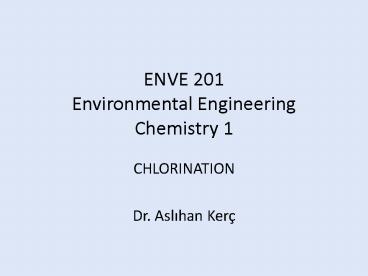ENVE 201 Environmental Engineering Chemistry 1 - PowerPoint PPT Presentation
Title:
ENVE 201 Environmental Engineering Chemistry 1
Description:
ENVE 201 Environmental Engineering Chemistry 1 CHLORINATION Dr. Asl han Ker Chlorination Disinfection of public water supplies and wastewater effluents. – PowerPoint PPT presentation
Number of Views:111
Avg rating:3.0/5.0
Title: ENVE 201 Environmental Engineering Chemistry 1
1
ENVE 201Environmental Engineering Chemistry 1
- CHLORINATION
- Dr. Aslihan Kerç
2
Chlorination
- Disinfection of public water supplies and
wastewater effluents. - To prevent spread of water borne diseases (?)
- Cholara, typhoid ? by contamination of drinking
water with wastewater - Chlorination forms THMs
3
- Alternative disinfectants
- Chlorine dioxide
- Ozone
- Emergency chlorination w/hypochlorites (1850)
- Continuous chlorination of public water supplies
- ? 1904 ( Calcium Hypochloride)
4
- Calcium Hypochloride ?instable during storage
?limited usage - Development of gaseous chlorine feeding
facilities ?increased use - Continual decline of waterborne disease
5
- Current increase in waterborne diseases
- Giardiasis
- Cryptosporidium
- Infectious Hepatisis ( viral infection )
Protozoa
6
Chlorine Chemistry
- Chlorine compound used in disinfection
- Chlorine gas Cl2
- Calcium Hypochlorite Ca(OCl)2
- Sodium hypochlorite NaOCl
- Chlorine dioxide ClO2
- (Cl- is not a disinfectant)
For small applications
7
- Cl2 when applied to water ? forms hypochlorous
acid and hydrochloric acid - Cl2 H2O ? HOCl H Cl- (1)
- Stability constant for this rxn
- K HOClH Cl- / Cl2 4.510 -4 _at_25
C
8
- Ionization
- HOCl ? H OCl- (2)
- K H OCl- / HOCl 2.9 10-8 _at_ 25 C
- Free available chlorine HOCl OCl-
Variable w / temperature
9
- Distribution between these species is important
- Killing effiency of HOCl is 40 -80 times larger
than OCl - . Lower pH favors HOCl. - HOCl Hypochlorous acid
- OCl - Hypochloride ion
10
- Percentage distribution of HOCl and OCl -
- HOCl/ (HOCl OCl - 1 / ( 1 (OCl - /
HOCl )) - 1 / (1 (Ki/ H
- Hypochlorite salts
- Ca(OCl)2 2H2O ? 2HOCl Ca(OH)2
- NaOCl H2O ? HOClNaOH
11
- Rxn(1) is dominated by Cl2. Obnoxious comp. NCl3
may form ?requires high quality water - For Chlorinator feed water ?use high quality
water - To avoid localized low pH ? flash mixing
12
- Above pH 4 ? equilibrium (1) shifts to right.
- Cl2 decrease pH
- Hypochlorites increase pH
- Rxns. with impurities in water
- Cl2 and HOCl react with ammonia and humic
material.
13
- Rxns with ammonia
- Ammonium ion is in equilibrium with ammonia and
hydrogen ion. - NH4 ? NH3 H
- NH3 react with Cl2 or HOCl (hypochlorous acid)
- Rxns are dependent on pH , temperature , contact
time , and Cl2 / NH3 ratio
14
- Dominant Species
- Monochloramine (NH2Cl) and Dichloramine (NHCl2) ?
combined available chlorine - Chlorine readily reacts with reducing agents.
- Fe2 , Mn 2 , H2S , organic matter Chlorine is
reduced to Cl. - H2S Cl2 ? 2HCl S
15
- These substances increase chlorine demand.
- Cl2 Phenols ?Produce mono-, di-,
- Trichlorophenols ? produce taste , odor
- Cl2 also reacts with other halogens
- Br- HOCl? HOBr Cl-
- HOBr Hypobromous acid
16
- Cl2 and HOBr reacts with humic substance
- ? Halogenated organics. THMs
- Suspected human carcinogens.
- Maximum contaminant level 100 µg/L ? 80
µg/L - Alternative disinfectants ?
17
- Cl2 is the only disinfectant producing protective
residual within the distribution systems. - Factors important in disinfection
- Time to contact
- Concentration
- Kill a Cn t
18
Generalized curve obtained during breakpoint
chlorination
19
Break Point Chlorination
20
Break Point Chlorination
- Cl2 / NH3 ratio 11 for the formation of mono ,
dichloroamines. - Further increase in mole ratio ? trichloramine,
oxidation of part of ammonia to N2 or NO3-. - These rxns. are completed at mole ratio 1.51
- Chloramine residuals maximum _at_11mol
- Then decline to a minimum till 1,51
21
Breakpoint Chlorination
- Chlorination of a water to the extent that all
the ammonia is converted to N2 or higher
oxidation states. - Theoretically
- 3 mole chlorine ? conversion to trichloramine
- 4 mole chlorine ?complete oxidation to nitrate
- 2NH3 3Cl2 ?N2 6H 6Cl-
22
- Breakpoint chlorination ? for better
disinfection, required to obtain free chlorine
residual , if ammonia is present. - Method of ammonia removal in ww
- Combined chlorine residuals ? Longer lasting (
final treatment with ammonia ) - Chlorine demand Amount of chlorine that must be
added to reach a desired level of residual.
23
Chlorine Residual Determination
- Old Methods ? total chlorine
- New Methods ? free and combined chlorine
- Total Chlorine Residual
- Measurement depend on measuring the oxidizing
power - Other oxidizing agents present may interfere ?
manganese, nitrites
24
Starch Iodide Method
- Oxidizing power of free and combined chlorine to
convert iodide to iodine. - Cl2 2I- ?I2 2Cl-
- I2 starch ?blue color
- Blue color ? shows the presence of free chlorine.































